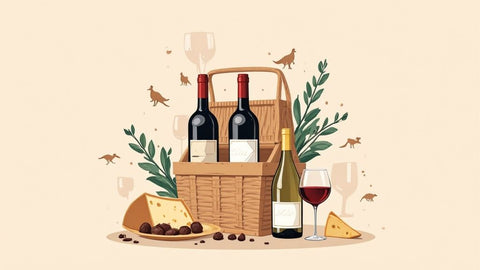Introduction: A Deep Dive into McLaren Vale Wines
McLaren Vale is one of Australia’s most celebrated wine regions, prized for concentrated red-fruit characters, generous tannins and an ability to express site-specific differences. This comprehensive guide explains how to taste McLaren Vale wines deliberately and confidently, so terroir signatures, oak influence and ageing potential become clear. The method below is designed for enthusiasts, collectors and anyone who values curation, sustainability and authentic regional expression.
Why a Structured Tasting Matters
- Consistency: A repeatable routine removes guesswork and makes comparisons meaningful across vintages and producers.
- Clarity: A method helps separate primary fruit, winemaking influence and terroir-derived notes.
- Selection: Better tasting leads to smarter purchases — prioritising wines that match palate preference and cellaring goals.
Quick Overview of McLaren Vale Terroir
- Climate: Mediterranean, with warm growing seasons and cooling sea breees that help retain natural acidity.
- Soils: Diverse — terra rossa over limestone, sandy loam and ironstone. Soil variation is a primary reason for distinctive site expression.
- Grapes: Shiraz, Grenache and Cabernet Sauvignon dominate, with complementary plantings of Mourvèdre, Chardonnay and alternative varieties.
- Viticulture: Old-vine blocks, low-yield parcels and site selection contribute significantly to concentration and longevity.
Preparing for a Serious Tasting
- Choose a neutral, quiet space with natural or soft lighting and no strong odours.
- Use clean, clear glasses with a tulip shape or broader bowl for reds to capture aromas and allow movement.
- Have plain water and bland crackers available to cleanse the palate between samples.
- Avoid tasting immediately after eating spicy or aromatic foods.
- Record notes — a simple template makes later comparison far easier.
Step-by-Step Sensory Protocol
-
Sight: Colour, Clarity and Legs
- Hold the glass at an angle against a white background. Note depth of colour, hue at the rim and any browning that indicates age.
- Rapid, persistent legs suggest higher alcohol or glycerol from riper fruit or certain winemaking practices.
-
Swirl: Release Aromatics
- Swirling oxygenates the wine and brings volatile compounds to the surface. Observe how quickly aromas open.
-
First Nose: Primary Fruit and Floral Lift
- Detect immediate fruit notes: cherry, plum and blackberry are common for Shiraz and Grenache; blackcurrant and herbaceous notes for Cabernet.
- Notice floral or lifted components such as violet or lavender on some Grenache expressions.
-
Second Nose: Winemaking and Oak Signals
- Look for fermentation or lees-derived notes: bread dough, citrus zest or creamy lees in whites; faint spice or reductive characters in reds.
- Identify oak-derived aromas: vanilla, baking spice, toast, cedar or smoke. Judge whether they are framing or dominating the fruit.
-
Palate: Texture, Structure and Flavour Evolution
- Take a medium sip and aerate the wine in the mouth. Note attack (freshness), mid-palate (concentration) and finish (length).
- Assess acidity (tension), tannin (grip and grain), body and alcohol balance. Look for persistence of flavour on the finish.
-
Integration: How Components Interact
- Judge whether acid, tannin, fruit and oak are balanced. A well-integrated wine will evolve in the glass without any single element overpowering the others.
-
Ageing Potential: Predicting Development
- Use markers such as energy of acidity, fine-grained tannins, fruit concentration and oak restraint to estimate cellaring windows.
Extended Tasting Exercises
To deepen sensory acuity, try these exercises during a tasting session.
- Blind Comparative Tasting: Pour several wines without revealing labels and compare terroir markers, oak intensity and tannin quality.
- Oak Blind Test: Compare two versions of the same variety — one matured in new oak, the other in seasoned oak or concrete — to isolate oak influence.
- Ageing Progression: Line up the same bottling from different vintages or the same vintage with different bottle ages to observe tertiary development and evolution.
- Single-Vineyard Focus: Taste wines from different sites within McLaren Vale to map soil and aspect influence on aroma and structure.
Terroir: How Soil, Aspect and Maritime Influence Show in the Glass
- Terra rossa and limestone: Commonly create wines with bright red-fruit clarity, pronounced minerality and a nervous acid backbone.
- Ironstone and deep loams: Often yield dense, plush tannins and darker fruit concentration — a hallmark of many powerful Shiraz wines from the region.
- Coastal proximity: Cooler nights and sea breezes help preserve acidity; wines from cooler aspects can show saline or herbal notes and elevated freshness.
- Old-vine influence: Lower yields and mature root systems tend to concentrate flavour and produce more nuanced tannin profiles that age gracefully.
Winemaking Choices That Shape Tasting Outcomes
- Fermentation regimes: Wild ferments can introduce complexity and savoury notes, while cultured yeasts often preserve primary fruit purity.
- Maceration and extraction: Extended maceration increases tannin and colour extraction, affecting structure and ageing potential.
- Malolactic fermentation: Softens acidity and adds textural creaminess, particularly noticeable in fuller-bodied whites and some reds.
- Whole-bunch and carbonic techniques: Can introduce spicy, floral and savoury characters, particularly in Grenache and lighter reds.
- Use of concrete, stainless steel and amphora: Minimal oak vessels preserve fruit and terroir; concrete can add textural lift without pronounced oak influence.
Decoding Oak: Type, Age and Toasting
- New oak percentage: Higher percentages tend to bring obvious vanilla, coconut and spice; lower percentages are subtler and often preferable for terroir-led wines.
- Oak origin: French oak often contributes spice, cedar and fine tannin; American oak can impart sweeter coconut and vanilla notes; European oak types offer varied spice profiles.
- Barrel size and format: Smaller barrels intensify oak influence due to higher surface area to volume; larger formats and foudre mellow oak impact and encourage texture.
- Toasting levels: Light toast preserves tannin lift; medium-plus results in smoky, coffee or chocolate notes that can add complexity when well integrated.
- Micro-oxygenation and barrel age: Older barrels contribute texture and slow oxygen exchange without strong flavour imprint, assisting in tannin softening and polymerisation.
Ageing Potential: How to Read the Signs
Estimating how a wine will develop in bottle is a nuanced assessment. Key indicators include:
- Tannin structure: Fine-grained, ripe tannins are a green light for long-term cellaring. Coarse, drying tannins suggest more immediate drinking or the need for careful bottle maturation.
- Acidity: Bright acidity is essential to lift and preserve freshness during long ageing.
- Fruit concentration and balance: Generous fruit that sits balanced within acid and tannin is most likely to transform gracefully over years or decades.
- Oak restraint: Overly dominant new oak can mask fruit and make assessment of ageing potential harder; well-managed oak supports structure without obscuring site character.
Practical Cellaring Guide for Common Varieties
- Shiraz: Everyday and mid-tier Shiraz are often approachable within 3–7 years. Powerful, site-driven Shiraz from old vines and concentrated parcels can cellar 10–20+ years.
- Grenache: Many Grenache wines are accessible young (1–5 years) thanks to supple tannins, though barrel-aged or whole-bunch examples may develop beautifully over 5–12 years.
- Cabernet blends: Structured examples with good acidity and tannin can age 8–20 years depending on concentration and oak handling.
- Whites (Chardonnay and others): Crisp, terroir-focused whites are often best within 2–6 years, while barrel-fermented, oak-aged Chardonnays can reward medium-term cellaring of 5–12 years.
Decanting and Opening Older Bottles
- Young, powerful wines: Decant 30–90 minutes to allow aromatics to unfurl and tannins to soften.
- Medium-aged wines (5–15 years): Decant 15–60 minutes depending on concentration and oak — monitor aroma development.
- Older wines (15+ years): Decant carefully to remove sediment and expose delicate tertiary aromatics; consider decanting over a sieve and serving promptly to avoid rapid dissipation of fragile aromas.
- Sediment management: Stand older bottles upright for 24 hours before opening to let sediment settle; pour slowly and stop at the last clear drop.
Storage Best Practice
- Temperature: Aim for stable 12–15°C; fluctuations accelerate ageing and can damage corks and labels.
- Humidity: Moderate humidity (60–75%) prevents cork drying while reducing mould risk on labels.
- Light: Store in darkness — UV and strong light accelerate colour and flavour deterioration.
- Position: Store bottles on their side if sealed with a traditional cork to keep the cork moist; screwcap bottles can be stored upright.
- Vibration: Minimise movement to avoid disturbing lees or accelerating chemical reactions.
Food Pairing Principles and Example Matches
Pairing McLaren Vale wines is about balancing intensity, flavour profile and texture.
- Powerful Shiraz: Matches charred red meats, slow-cooked beef brisket, smoked dishes and spicy barbecue flavours. Rich sauces with a touch of sweetness enhance the wine’s ripe fruit and spice notes.
- Grenache and Grenache blends: Best with roasted poultry, tomato-based pasta, grilled vegetables and lighter cured meats. The red-fruit brightness and floral lift complement Mediterranean-style dishes.
- Cabernet blends: Pair with slow-braised dishes, lamb and mushrooms. Herbaceous or mint-accented sauces work well with the variety’s structural profile.
- Barrel-aged whites: Complement creamy seafood dishes, buttered pasta and roasted vegetables; acidity balances richness.
Tasting Vocabulary and Glossary
- Primary aromas: Fruit, floral and varietal characters derived from the grape.
- Secondary aromas: Fermentation and lees-derived aromas such as bread dough, cream or butter.
- Tertiary aromas: Ageing-derived notes like tobacco, leather, earth and dried fruit.
- Acidity: The sense of freshness or lift on the palate; critical for balance and longevity.
- Tannin: Phenolic grip from skins, seeds and oak; provides structure and ageing ability.
- Finish: The lingering flavours after swallowing; length indicates concentration and persistence.
Tasting Note Template and Example
Use this template to capture clear, useful notes.
- Appearance: colour, clarity, viscosity.
- Nose: primary, secondary and tertiary aromas with intensity scale.
- Palate: attack, mid-palate, acidity, tannin, alcohol, texture and finish length.
- Balance: integration of components and overall harmony.
- Ageing potential: recommended drinking window with confidence level.
- Food pairing: suggested dishes.
Example summary: Deep ruby core with purple rim. Nose of black plum, blackberry, pepper spice and toasted cedar. Palate shows ripe tannin, bright acidity, concentrated dark fruit, 30–40 second finish. Well balanced; suggests 8–15 years cellaring. Serve with char-grilled beef or slow-braised lamb.
Buying, Curation and Sustainable Selection
- Prioritise wines that reflect site specificity and restraint in oak — these tend to showcase terroir and age more gracefully.
- Look for producers who emphasise sustainable viticulture, old-vine parcels and careful cellar decisions for longer-lived wines.
- Curation is about quality over quantity: select a mix of ready-to-drink bottles and a few candidates for medium and long-term cellaring.
- Seek small-batch or site-designated bottlings to better experience the region’s diversity and authenticity.
Frequently Asked Questions
- How often should I taste wines to improve? Regular, focused sessions — even short weekly tastings — build recognition of aromas, textures and patterns.
- Is bigger oak always better for ageing? No. Properly judged oak supports structure but excessive new oak can mask fruit and make long-term assessment difficult.
- Can older bottles still develop positively? Yes, if they have the right balance of acidity, tannin and fruit concentration. Condition and storage history are crucial.
Conclusion: Taste with Intention
Tasting McLaren Vale wines with a methodical approach reveals more about site, vintage and winemaking choices than casual sipping. Focus on sight, nose and palate in a disciplined sequence, compare blind when possible, and keep records. Prioritise authentic, sustainably produced wines and curated selections to enjoy a meaningful exploration of the region. With practice, reading terroir, oak influence and ageing potential becomes intuitive — guiding confident purchases and memorable drinking experiences.
Core Values Reminder
Choosing wines that emphasise authenticity, thoughtful curation, sustainability and enjoyment will best showcase McLaren Vale’s unique character. These values support discovery, community connection and a cellar that balances exclusivity with accessibility — ensuring memorable wines are available now and for future enjoyment.




Comments (0)
There are no comments for this article. Be the first one to leave a message!